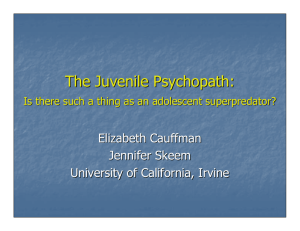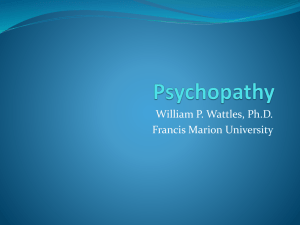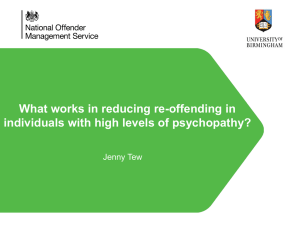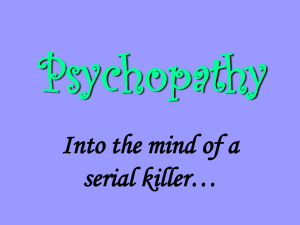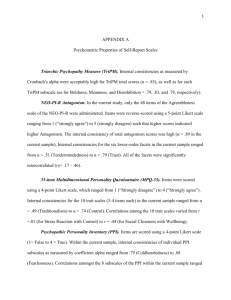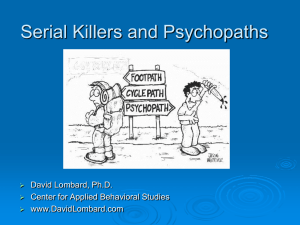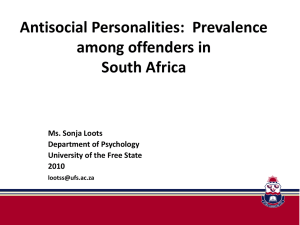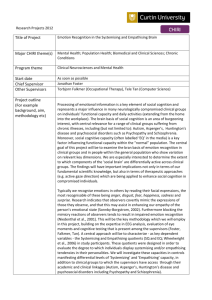Document
advertisement
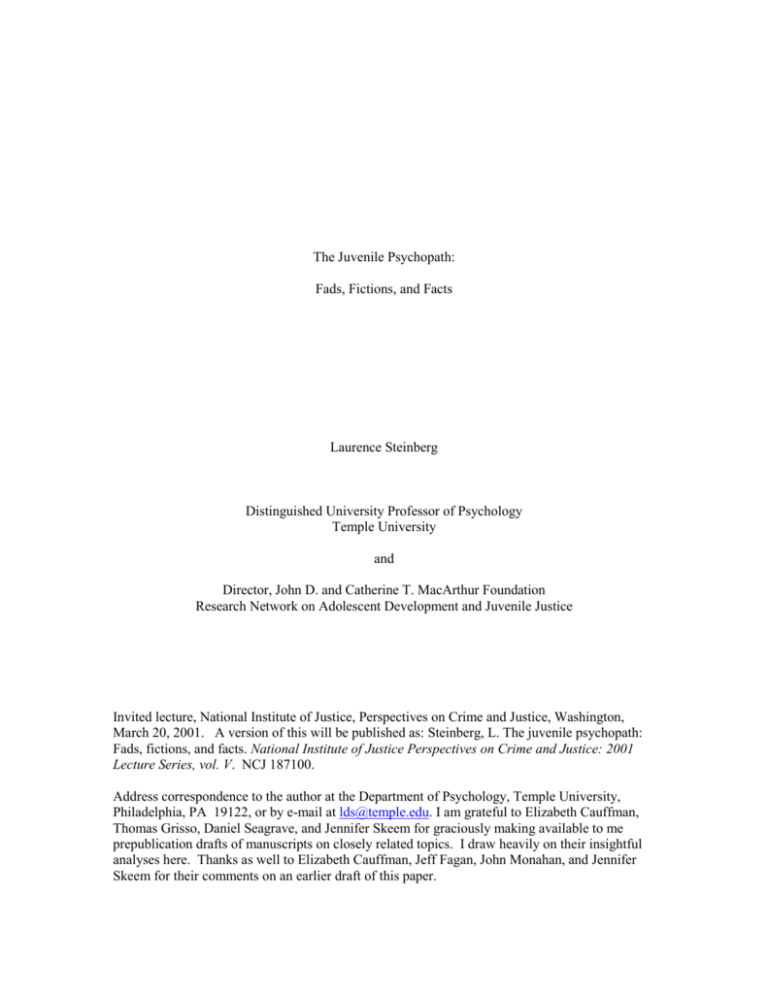
The Juvenile Psychopath: Fads, Fictions, and Facts Laurence Steinberg Distinguished University Professor of Psychology Temple University and Director, John D. and Catherine T. MacArthur Foundation Research Network on Adolescent Development and Juvenile Justice Invited lecture, National Institute of Justice, Perspectives on Crime and Justice, Washington, March 20, 2001. A version of this will be published as: Steinberg, L. The juvenile psychopath: Fads, fictions, and facts. National Institute of Justice Perspectives on Crime and Justice: 2001 Lecture Series, vol. V. NCJ 187100. Address correspondence to the author at the Department of Psychology, Temple University, Philadelphia, PA 19122, or by e-mail at lds@temple.edu. I am grateful to Elizabeth Cauffman, Thomas Grisso, Daniel Seagrave, and Jennifer Skeem for graciously making available to me prepublication drafts of manuscripts on closely related topics. I draw heavily on their insightful analyses here. Thanks as well to Elizabeth Cauffman, Jeff Fagan, John Monahan, and Jennifer Skeem for their comments on an earlier draft of this paper. 1 This morning, I’d like to talk about a worrisome practice that I believe is becoming increasingly common in prosecutions of serious juvenile offenders – the characterization of the juvenile offender as a “psychopath,” a “budding psychopath,” or an individual with “psychopathic tendencies.” I do not have hard data to validate my suspicion that this practice has in fact become more common in recent years (but see Edens et al., 2001), but my work on adolescent development and juvenile justice brings me into regular contact with prosecutors, defense attorneys, and judges, and the frequency with which I am asked questions about psychopathy and its diagnosis among juveniles has undoubtedly increased. Whether this reflects a genuine trend may depend as much on one’s definition of psychopathy as it does on one’s definition of what constitutes a trend. As some of you know, to a social scientist, one case constitutes an anecdote; two cases, data; three, a pattern; and four, a trend. At least four practitioners have asked me about this issue in the past year, so we may be talking about a trend. Regardless of whether labeling some youngsters as true or incipient psychopaths affects four, forty, or four thousand juveniles a year, there is, nevertheless, a good deal to worry about the practice, and there are many reasons to sound a note of caution within the juvenile and criminal justice systems about the potential overuse of psychopathy as a diagnostic label when applied to juveniles. Juveniles who are branded as psychopaths are more likely to be viewed as incorrigible, less likely to receive rehabilitative dispositions and, if it is an option, are more likely to be transferred to the criminal justice system, where they will be tried as adults and face the possibility of adult sanctions, including incarceration in adult jails and prisons. As I shall argue, we are not sure if the construct of psychopathy makes sense when applied to adolescents and children, we are not sure that measures of psychopathy are stable over the course of adolescence or between adolescence and adulthood, and we have no data on the predictive utility of the diagnosis when applied to juveniles. For these reasons, we are not ready – if indeed we ever will be – to base transfer or other dispositional decisions on diagnoses of psychopathy among juveniles. Similar arguments have been made recently by other scholars, most notably, Elizabeth Cauffman and Jennifer Skeem at the University of Pittsburgh, Daniel Seagrave and Thomas Grisso, at the University of Massachusetts Medical School, and John Edens and Keith Cruise at Sam Houston University. The ideas presented in this paper borrow heavily from the contributions of these other writers, and I am grateful to them for their willingness to share with me drafts of articles that have yet to be published. Let me begin with a brief introduction to the construct of psychopathy and its uses and misuses in clinical and forensic practice. First, I want to distinguish between two similar words with different meanings for those of you in attendance who do not have a background in psychology or psychiatry. Psychopathology refers to any sort of psychological disorder that causes distress either for the individual or those in the individual’s life. Depression, schizophrenia, attention deficit hyperactivity disorder, alcohol dependency, conduct disorder, and bulimia are all forms of psychopathology. Most researchers use the term “psychopathology” loosely, to refer to a continuum of problems that ranges from mild discomfort to full-blown psychosis. Psychopathology can be ascertained through the administration of standardized tests or questionnaires, or through some form of diagnostic clinical interview. 2 Psychopathy, in contrast, refers to a very specific and distinctive type of psychopathology. Psychopathy is a type of personality disorder defined chiefly by a combination of antisocial behavior and callousness and emotional detachment. As one set of writers recently noted, “Psychopaths are typically charismatic individuals who readily manipulate others and engage in risky behaviors designed to satisfy their own personal needs. They are undeterred by pangs of conscience and have little or no concern for the welfare of others. Their relationships tend to be shallow and they often meander from one opportunistic setting to another without much concern for the future” (Poythress, Skeem, Lilienfeld & Edens, 2000). Although psychopathy is often treated as a unidimensional construct, current thinking is that what we call psychopathy is actually composed of two related, but independent, components. Factor I reflects a cluster of affective and interpersonal features best described as callous emotional detachment (e.g., glibness, egocentricity, superficial charm, shallow affect), whereas Factor II represents the chronic unstable and antisocial lifestyle (e.g., irresponsibility, boredom proneness, impulsivity, criminality) associated with psychopathic individuals. The fact that psychopathy is defined by two factors – one having to do with emotional detachment and the other having to do with antisocial behavior – is very important in understanding why it may or may not be useful in predicting future dangerousness among juveniles. Psychopathy, as it is presently defined, is very similar to what psychologists call a personality disorder (indeed, although it is not listed in the DSM as a personality disorder, it has many characteristics in common with antisocial personality disorder, and some have argued that psychopathy should be viewed as a subtype of antisocial personality disorder (e.g., Poythress, Skeem, Lilienfeld, & Edens, 2000). Personality disorders are unlike other forms of psychopathology, which are viewed as potentially treatable (or at least manageable) conditions. In contrast to disorders like depression or conduct disorder, however, psychopathy is presumed to represent a pattern of personality and behavior that is deep-seated, originating in early experience and/or biological functioning, relatively stable over time, and resistant to change, if not absolutely immutable. The assessment of psychopathy is generally done via structured interviews. In studies of adults, the gold standard from which most other measures derive is the revised version of the Psychopathy Checklist, or PCL. A slightly revised version of this measure, the PCL Youth Version, is now available for use with adolescents. The PCL, developed by Robert Hare, the North American authority on psychopathy and its assessment, is a measure that is based on a series of ratings that a trained expert makes on the basis of the individual’s interview responses and information taken from the respondent’s file or official records. The rater assigns a score of 0, 1, or 2 for each of 20 dimensions. The field generally uses a cut-off score of 30 to designate an individual as a psychopath. Before turning to questions about the appropriateness of using the psychopathy diagnosis for making dispositional decisions about juvenile offenders, a few words are in order about the use of this construct in making judgments about adults. First, there seems to be little disagreement about the utility of the construct, “psychopath,” in describing certain adult criminals. There is a substantial literature suggesting that criminals who score high on the PCL can be distinguished from their non-psychopathic counterparts in theoretically meaningful ways on other personality measures and on measures of 3 information-processing and decision-making. Studies of neuropsychological functioning suggest that at least some portion of individuals who score high on the PCL may be “wired” differently in a way that could conceivably contribute to their criminality. Second, there is near consensus that the PCL, as an assessment device, is a valid and reliable way with which to measure psychopathy among adults, although several writers have suggested that there is room for improvement (e.g., Harris, et al., 2000) and others have argued that there are three, not two, underlying factors (e.g., Cooke and Michie, in press). Reliability here refers to agreement between raters who are assessing the same individual. Estimates of the over-time reliability of PCL scores are more difficult to calculate, since at least some of the score an individual receives is based on facts that are in the individual’s record. Because these facts do not change, certain elements of the individual’s PCL score remain fixed and therefore artificially inflate estimates of the over-time reliability of the measure. Nonetheless, by conventional social scientific standards, the PCL is a more than acceptable psychological instrument. Third, and most important, as a predictive tool, the PCL is unrivaled in its ability to predict future antisocial behavior; it is especially good at predicting future violence. For example, a recent meta-analysis of findings from several large-scale follow-up studies reported modest but significant correlations between scores on the PCL and general recidivism, violent recidivism, and sexual recidivism (Hemphill et al., 1998). Psychopathic individuals (i.e., those obtaining PCL scores > 30) were approximately four times as likely to commit a future violent crime than were non-psychopathic offenders. Moreover, the PCL “has been found in many studies to perform as well as (and in some cases better than) statistically derived actuarial measures designed specifically to predict future violence” (Edens et al., 2001). In the MacArthur Violence Risk Assessment Project, the PCL was the single best predictor of future violence out of a set of 134 predictors (Steadman et al., 2000). This does not mean that the PCL is fantastically accurate in predicting future criminal behavior, only that, in comparison to other instruments designed for the same purpose, the PCL does a better job than anything else available. Whether this level of accuracy is acceptable for making decisions about an individual is a more complicated matter, and one that, as experts in risk assessment like John Monahan (1981) have pointed out, is best determined by legal practitioners, not social scientists. One of the factors that must weigh heavily in any decision regarding the use of an imperfect risk assessment instrument is whether the consequences of a false positive classification – that is, the classification of an individual as high-risk when he in fact is not – carry unintended harmful effects. If, for example, the outcome of being classified as a psychopathic individual is long-term incarceration, it would not be advisable to accept a high false-positive rate. If, on the other hand, a classification of this sort is used simply to hold an individual for a few days pending further evaluation, the same false-positive rate may be acceptable in light of the potential benefits to community safety derived from identifying the small number of genuinely dangerous individuals. My concern is that assessments of juvenile psychopathy are not being used to recommend further evaluation but are, instead, forming the basis for definitive dispositional decisionmaking. The fact that assessments of juvenile psychopathy are being used to make decisions about the transfer of young offenders into the adult system – decisions that necessarily imply judgments about the likelihood of individual rehabilitation and that 4 effectively determine whether any attempt will be made to rehabilitate the young offender – makes any false-positive problem especially worrisome. In sum, then, at least when speaking about adults, we can say the following: (a) it makes sense to characterize some criminals as psychopaths, (b) it is possible to do so using the Psychopathy Checklist, and (c) knowing whether an individual scores high on the PCL is useful information to have when trying to predict an individual’s risk for future criminality or violence. It is against this backdrop that I want to consider the use of the PCL and other instruments designed to assess psychopathy to make decisions about juvenile offenders. Let me begin by speculating on why I think psychopathy has become in recent years an attractive notion to those interested in serious juvenile offenders. It is instructive to examine the current interest in the juvenile psychopath in historical perspective, because there are striking parallels between today’s situation and that which existed in the early decades of the 20th century, during the beginning years of the juvenile justice system. Historian Michael Willrich has written a marvelous description of what he calls “eugenic jurisprudence” in the early part of the 20th century (1998), and it is fascinating to read this while pondering the juvenile psychopathy question before us today. It is the alignment of four factors today, as was the case 80 years ago, that is driving the contemporary search for the nascent Hannibal Lecter. These four factors are: (1) a problem; (2) a crisis; (3) a theory; and (4) a diagnostic tool. The Problem One of the most difficult problems facing practitioners in the juvenile justice system today is differentiating between serious offenders who are at risk for continuing to offend and those who are not. This is an especially important challenge to those making transfer recommendations, both because we want to protect the community from individuals who have a high risk of reoffending, especially if the risk is for violent reoffending, and because we do not want to expose young people who are relatively low risk to the likely iatrogenic effects of adult sanctions. If it were possible to differentiate between juveniles who are at high risk for reoffending and juveniles who are not, we could, in theory, make far better decisions regarding transfer to the adult system, the decertification of juveniles charged as adults, and so forth. The problem facing legal practitioners in the early 20th century was much the same: how to draw meaningful distinctions among offenders who had committed similar offenses. As Harvard Law School professor Roscoe Pound noted early in the 20th century, “Criminals must be classified as well as crimes” (Willrich, 1998, p. 82). In 1909, the first court-affiliated psychiatric clinic was founded in Chicago, attached to the nation’s first juvenile court, and designed to “assist judges in devising a disposition or ‘treatment’ appropriate for each offender and to conduct policy-shaping clinical research into the ‘root causes’ of crime” (Willrich, 1998, p. 82). Coincidentally, and ironically, in light of the topic of this paper, the clinic was named the Psychopathic Institute; a sister clinic, the Psychopathic Laboratory, served the Municipal Court. As the Chief Justice of the Municipal Court explained, “the idea [of the Psychopathic Laboratory] marks a turning point from the traditional policy of society of treating the delinquents as a single large class…without consideration of the various individual characteristics which distinguish them, and are now seen to divide them into a number of sharply differentiated 5 classes, each with its separate proclivities, potentialities, and prognostic characteristics” (Willrich, 1998, p. 82). The Crisis Each of the problems noted above was made more pressing by a crisis, or, at the very least, by the public’s perception of one. Today’s sense of urgency over the need to determine which offenders are genuine psychopaths and which are not has its origins in the now infamously wrong prediction about the coming wave of superpredators made by prognosticators like John DiIulio (e.g., Bennett, DiIulio, & Walters, 1996). DiIulio has since softened his views on the inevitability of an epidemic of juvenile violence, but the legacy of the superpredator lives on today in the label of the psychopath. If DiIulio had a counterpart in the early days of the juvenile court, it may well have been Harry Olson, the Chief Justice of Chicago’s Municipal Court. Olson’s speeches about the growing “menace of the feeble-minded” – a term that was used to refer not only to the mentally retarded, but to individuals characterized by any number of mental deficiencies – sparked the same sort of panic and ill-informed changes in policy and practice as DiIulio’s incendiary Wall Street Journal op-eds about superpredators would do some 75 years later. Indeed, as Willrich points out, “by the mid-teens, the discourse about ‘the menace of the feeble-minded’ had spilled over from the welfare circles and professional journals into popular culture” (1998, p. 90), in much the same way that the inside-the-beltway musings of DiIulio and other conservative pundits eventually found their way into Time magazine and onto the evening news. There are parallels in practice between then and now as well. Just as today’s prosecutors propose to use the diagnosis of psychopathy as grounds for the transfer of juveniles into the adult system, their forefathers advocated using feeble-mindedness as grounds for commitment. In neither time do practitioners pay much attention to the problem of false positives. The Theory Although warnings about the wave of superpredators in the 1990s, and the epidemic of feeblemindedness in the 1920s, were based more on rhetoric than reality, more on politics than precise evidence, the translation of the rhetoric into policy and practice necessitated two other ingredients: a saleable theory about the origins of the condition, and an available diagnostic test to distinguish those who had the condition from those who did not. Interestingly enough, during both eras the theoretical perspective that carried the most weight was one that emphasized the organic bases of criminal behavior. During the early part of the 20th century, the work of the neurologist William James Hickson, whom Judge Olson recruited to direct the Municipal Court’s Psychopathic Laboratory, was especially influential, at least in Chicago, and as juvenile justice practice went in Chicago at the turn of the century, so it went in the nation. Hickson, who had studied in Europe with Kraepelin and Bleuher, two of the most influential thinkers in the history of psychiatry, and in the United States with Goddard, who popularized the use of the BinetSimon intelligence test in this country, created “a fascinating synthesis of organic psychiatry and eugenic criminology” (Willrich, 1998, p. 89). Hickson believed that the central cause of criminality was not low intelligence (the conventional definition of 6 feeblemindedness and, at the time, one of the presumed causes of criminal behavior) but an “affective defect” characterized by apathy, lack of remorse, and so on – not unlike notions of “moral insanity” that had been popularized during the mid 19th century (see Maughs, 1941a, 1941b), and remarkably similar to the callous emotional detachment that defines one of the core components of psychopathy as it is assessed via the PCL. Hickson believed that this affective defect was inherited in the form of “dementia praecox,” a catch-all diagnosis for serious mental disorder popularized by one of his mentors, Kraepelin. Hickson also believed that it was possible to pinpoint the anatomical site of the defect – the lower brain. Although little is written today about the genetic basis of psychopathy, there is no shortage of references in current writing about antisocial behavior, or about psychopathy in particular, to the possible organic bases for the disorder. The notion that a subset of chronic offenders are biologically different from their counterparts is central to the dominant theories of the development of antisocial behavior today, such as that put forth by Terrie Moffitt (1993), whose widely-cited model of juvenile offending distinguishes adolescent-onset criminality (which presumably is environmental in origin) from lifecourse-persistent criminality (which, in addition to its earlier onset and later offset, is presumed to have a strong biological basis); as well as prominent in the works of the leading writers on the subject of psychopathy, including Joseph Newman (1998), Paul Frick (1998), Adrian Raine (1998), and Robert Hare himself (Hare, 1984). Psychopathy has been attributed, in recent years, to low serotonin levels, low autonomic reactivity, unusual patterns of physiological arousal, and prefrontal cortical dysfunction. It has become increasingly common at professional meetings to see “pictures” of criminal brains; whether this is genuinely informative or simply high-tech phrenology remains a matter of some controversy. What’s important, though, is that at the beginning and again at the end of the 20th century, a theory, or set of theories, suggested that there exists a subpopulation of serious offenders whose criminality is (a) caused by some sort of affective defect; (b) based in some sort of organic brain deficit; and (c) deserving of some sort of special treatment within the justice system. In each historical period, the scientific legitimacy of the theory provided a foundation upon which a change in practice, and, by extension, policy, was fashioned. The Diagnostic Tool The confluence of a problem, a crisis, and a theory about serious offenders might influence discussion and debate, but in order to influence day-to-day practice, it is necessary to not only lead practitioners to the water but to provide them with the cup with which to drink it. Nothing succeeds in this task so well as a test. Indeed, as Thomas Grisso has argued, although we typically think of practice as being driven by policy, in many instances, the reverse is true. As they become widespread, changes in practice made possible by the introduction of new measures or assessment instruments often lead, over time, to changes in policy. In the 1920s, the search to identify criminals with the affective defect of dementia praecox was greatly facilitated by the availability of the Binet-Simon intelligence test, whose use had become increasingly widespread in the years following World War I. One would not think an IQ test would be very helpful in the search for affectively defective 7 individuals, but in this case, necessity was the mother of misuse. Hickson, eager to please the Judge who had appointed him (a judge who firmly believed that the menace of feeblemindedness was epidemic), to build his own reputation as a theorist and diagnostician, and to promote the Psychopathic Laboratory, began using the Binet, which had been designed solely to measure certain aspects of intelligence for purposes of identifying children who needed special educational programs, as a means of identifying individuals with the affective defect presumed to underlie intractable criminality. On the basis of individuals’ scores on one subtest of the Binet – a visual memory test – Hickson and his colleagues would make diagnoses and recommendations to judges that were used to justify the incarceration of certain offenders. These psychiatric work-ups were especially important in cases involving juveniles and females, because it was in these cases that the courts were most interested in assessing the amenability of the offender to rehabilitative intervention, and it was precisely this that Hickson believed he could assess (Willrich, 1998). All of the elements that led to interest in the diagnosis of dementia praecox among juvenile offenders in the early decades of the 20th century – the problem of prediction, the perceived crisis of epidemic feeblemindedness among inner-city youth, and the theory of organically-based criminality – were present in a more contemporary form at the end of the 20th century. And, just as the existence of a diagnostic tool – in the 1920s, the BinetSimon test of intelligence – concretized these elements into a practice that influenced legal decision-making early in the 20th century, the growing and, in some senses, wellfounded popularity of the PCL as a diagnostic instrument in assessments of adults more recently, in the context of a problem, a crisis, and a theory about juvenile offending, has made the use of versions of the PCL, or adaptations of it designed for the assessment of juveniles, all but inevitable in the evaluation of juvenile offenders. Whether the use of these youth-friendly PCL instruments – now, there’s an oxymoron if there ever was one – for purposes of making transfer decisions today is as problematic as was the use of the Binet for making commitment decisions 80 years ago is a topic I turn to next. Let me begin by noting what should be obvious – that using a measure based on a well-validated and reliable instrument designed to assess psychopathy among adult offenders to perform a similar task among juveniles is not the same sort of problem as is using a test of visual memory to diagnose intractable criminality. I am not suggesting that researchers and practitioners who are using currently available measures of psychopathy with juvenile populations are committing the same sort of egregious mistakes that Hickson was making by using the Binet to make diagnoses of affective defect. At the same time, however, the translation of an instrument from one that is appropriate for use with one age group to one that is appropriate for use with another is far from worry-free. The fact that we have a problem, a perceived crisis, and a theory about juvenile offending that encourage us to grab onto an available diagnostic instrument should not make us ignore some very real dangers in doing so. Until certain fundamental questions about the use of the PCL and instruments derived from it are answered through systematic scientific research, practitioners should not be using such measures in forensic practice. (This is a conclusion I share with Edens et al. and with Seagrave and Grisso.) Nonetheless, there is evidence that practitioners are using PCLderived instruments for making transfer, sentencing, and decertification decisions, despite 8 the cautions (some of them transparently half-hearted) raised by some of the researchers who are invested (both emotionally and financially) in the use of these measures. In my view, there are three questions that we must answer before encouraging courts to take into account assessments of juvenile psychopathy in making sentencing, transfer, and decertification decisions: 1. Do measures of psychopathy mean the same thing when used in adolescent populations as they do when used in adult populations? This is the question of construct validity. 2. Are scores on measures of psychopathy derived during adolescence correlated with scores on measures of psychopathy derived during adulthood? This is the issue of stability. 3. Do scores on measures of psychopathology derived during adolescence predict antisocial behavior and violence during adulthood? This is the issue of predictive utility. Some research, by Elizabeth Cauffman and Jennifer Skeem, is about to be launched to examine these questions. When or until this work is completed, if the answer to any of these questions is “We don’t know,” the use of psychopathy assessments to make important decisions about juvenile offenders is premature. If the answer to any of these questions is “No,” the use of psychopathy assessments to make important decisions about juvenile offenders is bad practice, and perhaps even unethical practice. In order to look at these questions of construct validity, stability, and predictive utility more closely, I want to first remind you about the conceptualization and measurement of psychopathy among adults. As I noted, the construct of psychopathy is predicated on the notion that psychopathic individuals have a deep-seated, unchanging pattern of personality and behavior that has its roots in early experience and/or biology. The pattern is characterized by two broad factors: callous, emotional detachment, which includes such traits as grandiosity, manipulativeness, shallow affect, and failure to accept responsibility for one’s own actions; and an unstable antisocial lifestyle, which includes such traits as proneness to boredom, impulsivity, irresponsibility, and delinquency. Individuals who are callous and antisocial are presumed to be at higher risk for continued antisocial behavior and violence. Let me begin with the question of construct validity. Do the indicators of psychopathy when assessed in adolescence mean the same thing as do these indicators when assessed in adulthood? A different way of asking this is to ask whether the correlates of psychopathy are the same during different developmental periods. We know that it is not always the case that traits assessed at one point in development have the same meaning as they do at a different point in development. Consider, for example, an individual who refuses to cooperate with other people. During early childhood, this may indicate healthy independence; during adulthood, this may indicate selfishness or antisociality. Or consider this: Imagine that we separate a mother from her child for ten minutes and then we reunite them. Clinging behavior in a young child indicates a strong and healthy attachment, which is correlated with a variety of measures of positive functioning; the same clinging behavior in an older child may indicate insecurity and would likely be correlated with indicators of emotional and behavioral problems. 9 One of the worries I have about the assessment of psychopathy among adolescents is that many of the behaviors we associate with normal adolescent development are the same behaviors that we associate with psychopathy in adults. To be sure, some of the items used to judge psychopathy likely apply to younger as well as older offenders. These include pathological lying, manipulativeness, shallow affect, and poor anger control. For the most part, I think that these constructs mean similar things when observed in an adolescent as they do when observed in an adult. (I do not want to address the appropriateness of these items in assessments of preadolescent children, where they may in fact be problematic.) But, as I, Edens et al., Cauffman and Skeem, and Seagrave and Grisso have pointed out, many items that are central to the definition of psychopathy among adults may be erroneously viewed as indicators of psychopathy in an adolescent population, confused with normative adolescent development. These include grandiosity, proneness to boredom, lack of remorse/guilt, impersonal sexual behavior, goallessness, impulsivity, irresponsibility, failure to accept responsibility for one’s actions, and unstable interpersonal relationships. The MacArthur Foundation Research Network on Adolescent Development and Juvenile Justice, which I direct, is conducting a number of studies aimed at understanding the ways in which information about normal and atypical adolescent development can improve the quality of decision-making concerning young offenders in the juvenile and criminal justice systems. Among these projects is a large-scale study of adolescents’ competence to stand trial; a comparison of the impact of juvenile versus adult sanctions on serious offenders; several studies of the ways in which adults judge adolescents’ criminal culpability and blameworthiness, research on legal socialization (how young people acquire attitudes about the law) and a longitudinal study of “pathways to desistance.” (For more information, go to www.mac-adoldev-juvjustice.org). In our study of pathways to desistance, we are tracking 1200 juvenile felons in two cities – Philadelphia and Phoenix – in order to understand how they are affected by their experiences in the juvenile and criminal justice systems. Among the measures of individual functioning we use in this study is the Youth Version of the Psychopathy Checklist – which is considered the state of the art in the assessment of psychopathy among adolescents. At our site in Philadelphia, we struggle often over how to interpret the behavior of the 14- to 17-year-olds in our sample in light of the items that compose the PCL-YV. Does a 14-year-old who blames his friends for dragging him into a robbery qualify for a rating of failing to accept responsibility for his actions, or is he accurately describing a heightened susceptibility to peer pressure that is characteristic of teenagers at this age? Is a 15-year-old who does not know what he wants to do with his life goalless, or is this indicative of an individual in the midst of an adolescent identity crisis? Is a 16year-old who has a new girlfriend every other week someone who has unstable interpersonal relationships, or is he merely trying to figure out who he is and what he wants in a romantic partner? Is a 17-year-old who believes that he can drive while high grandiose or suffering from adolescent egocentrism? Even Cleckley, whose ground-breaking description of the psychopathic personality formed the basis for the PCL worried about this: Confused manifestations of revolt or self-expression are, as everyone knows, more likely to produce unacceptable behavior during childhood and adolescence 10 than in adult life. Sometimes persistent traits and tendencies of this sort and inadequate emotional responses indicate the picture of the psychopath early in his career. Sometimes, however, the child or the adolescent will for a while behave in a way that would seem scarcely possible to anyone but the true psychopath and later change, becoming a normal and useful member of society. Such cases put a serious responsibility on the psychiatrist (Cleckley, 1976, p. 270). In the same way that Moffitt (1993) argues that we cannot distinguish between adolescence-limited offenders and life-course persistent offenders by observing them only during adolescence, because their observable behavior may be identical, I wonder whether we can distinguish between psychopathic and nonpsychopathic teenagers on the basis of their scores on the PCL. The problem is that some, but not all, of the items on the PCL describe characteristics that, while potentially indicative of problems among adults, may indicate normative development (or at least, development within the normative range) among adolescents – transitory characteristics that disappear in most individuals by young adulthood. However, by definition, psychopathy is not something that individuals grow out of. Which brings me to the issue of stability. Assertions about the presence of psychopathy among the young are necessarily based on the presumption that scores on measures of psychopathy are stable over time. To my knowledge, we do not really know if this is true among adults, but the fact that we do not have data at all on the over-time stability of PCL scores among juvenile offenders is particularly problematic, since adolescence is inherently a time of change. I should note that the DSM does not permit the diagnosis of Antisocial Personality Disorder, the closest diagnosis in the psychiatric lexicon to psychopathy, among individuals under the age of 18. The diagnostic criteria for Antisocial Personality Disorder parallel the key features of psychopathy, as defined by the PCL. It is not clear why the diagnosis of antisocial personality disorder among adolescents is problematic but the diagnosis of psychopathy is not. Furthermore, it is not simply that psychopathy is presumed to be stable over time; it is also presumed to be resistant to change. Unfortunately, the over-time stability of traits is generally studied under constant contextual conditions. Assertions that aggression, or impulsivity, or antisociality are stable traits are generally derived from longitudinal studies that do not take into account whether the individual’s social environment remained unchanged over the same time period. Indicators of stability under constant conditions may not provide accurate estimates of stability under changing conditions. Therefore, saying something is stable under natural conditions (i.e., if nothing else changes) is not the same as saying it is immutable. In order to research this, we need more than studies that simply measure psychopathy at two points in time. Before we use assessments of adolescent psychopathy to draw inferences about the amenability of young offenders to rehabilitation, we need experiments that assign putative juvenile psychopaths to treatment and attempt to change them. We have some evidence that this is difficult to do in adults, but no evidence one way or the other on adolescents. My final worry concerns the predictive utility of the PCL in juvenile populations. Here, you will recall, the question is whether scores on the PCL that are derived during 11 adolescence are predictive of antisocial or violent behavior in adulthood. At first glance, this appears to be the easiest of the three questions to answer, because it requires only that we assess psychopathy during adolescence and antisocial or violent behavior during adulthood and see if the first predicts the second. Indeed, at least one team of researchers have done this, and their results indicate that adolescents’ scores on the PCL are predictive of the number of times they are convicted for violent offenses before the age of 21 (Forth & Burke, 1998). It is not quite so simple, however, to judge the predictive utility of the psychopathy assessments. The reason for this difficulty inheres in the two-factor structure of the PCL. As you will recall, one factor refers to the emotional and interpersonal aspects of psychopathy, whereas the second refers to the antisocial aspects of psychopathy. We know from a vast literature on antisocial behavior that the single best predictor of future antisocial behavior is past antisocial behavior, and that the single best predictor of future violence is past violence. At issue here, then, is whether psychopathy in adolescence, per se, is an especially good predictor of future antisocial or violent behavior. To the extent that the predictive utility of the PCL, or any other measure of psychopathy, inheres solely in the well-established link between past and future antisociality, we might as well just assess past antisociality and forget about trying to distinguish between psychopathic and nonpsychopathic individuals. And if this is the case, high scores on the PCL tell us nothing about individual amenability, which is, after all, the sort of inference that is being drawn from the PCL. Another way of thinking about this is asking whether there is any “value added” to be gained by assessing the elements of psychopathy that are not indicators of current or prior antisocial behavior, such as those items that make up the factor defined by callous, emotional detachment. Unfortunately, extant research does not provide a clear-cut answer to this question. Although the connections between current psychopathy and later offending are real, the links are largely due to the predictive significance of the antisocial factor – demonstrating what we know all too well: that earlier offending is predictive of later offending. In samples of adults, the links between the non-antisocial variables – grandiosity, glibness, shallow affect, and so on – and subsequent offending are statistically significant but very modest in size (Skeem & Mulvey, in press). Before we can recommend the use of psychopathy assessments in dispositional decision-making regarding juveniles – especially in dispositional decision-making that is based on assumptions about amenability – we need more research that looks specifically within the adolescent population at the predictive utility of those elements of psychopathy that are not themselves indicators of current antisocial behavior. Questions about the stability and predictive utility of the PCL and related measures can be answered with welldesigned longitudinal studies. And, while we do not have such research yet, and while such studies are time-consuming and expensive to conduct, they are clearly within the realm of scientific possibility. In closing, I want to return to what I think is the most difficult of the three questions I raised: Whether high scores on the PCL during adolescence indicate genuine psychopathy or something that is less worrisome. Many years ago, Anna Freud, the pre-eminent psychoanalytic theorist interested in adolescence, wrote what now is considered to be a classic article, entitled “Adolescence as a Developmental Disturbance.” Although few experts in adolescent 12 development continue to hold the view that we should see the period as one of temporary insanity – a view, however, that is espoused by many parents of teenagers – at least some of what Freud implied in this article is worth heeding. Many of the behaviors that adolescents engage in are behaviors that, if demonstrated by an adult, would indeed be indicative of psychopathology, if not necessarily psychopathy. Psychopathy is, by definition, not something that individuals grow out of. Adolescence, by definition, is. It is important that we do not confuse one with the other. 13 References Bennett, W., DiIulio, J., & Walters, J. (1996). Body count. New York: Simon & Schuster. Cleckley, H. (1976). The mask of sanity (5th ed.). St. Louis: Mosby. Cooke, D. J., & Michie, C. (in press). Refining the Construct of Psychopathy: Towards a hierarchical model. Psychological Assessment. Edens, J., Skeem, J., Cruise, K. & Cauffman, E. (2000). The assessment of juvenile psychopathy and its association with violence: A critical review. Behavioral Sciences & the Law, 18. Forth, A. & Burke, H. (1998). Psychopathy in adolescence: Assessment, violence and developmental precursors. In D. Cooke, et al. (Eds.), Psychopathy: Theory, research and implications for society, 205-229. Boston: Kluwer Academic. Frick, P. (1998). Conduct disorders and severe antisocial behavior. New York: Plenum. Hare, R. D. (1984). Performance of psychopaths on cognitive tasks related to frontal lobe functions. Journal of Abnormal Psychology, 93, 133-140. Harris, G. T., Skilling, T. A., Rice, M. E. (2000). The construct of psychopathy. Crime and justice: An annual review of research. Unpublished manuscript. Hemphill, J. F., Hare, R. D., & Wong, S. (1998). Psychopathy and recidivism: A review. Legal and Criminological Psychology, 3, 139-170. Maughs, S. (1941a). A concept of psychopathy and psychopathic personality: Its evolution and historical development: Part I. Journal of Criminal Psychopathology, 329-356. Maughs, S. (1941b). A concept of psychopathy and psychopathic personality: Its evolution and historical development: Part II. Journal of Criminal Psychopathology, 465-499. Moffitt, T. E. (1993). Adolescence-limited and life-course-persistent antisocial behavior: A developmental taxonomy. Psychological Review, 100, 674-701. Monahan, J. (1981). The clinical prediction of violent behavior. Washington: National Institute of Mental Health. Newman, J., (1998). Psychopathic Behavior: An Information Processing Perspective. In D. J. Cooke, A. E. Forth, & R. D. Hare (Eds.), Psychopathy: Theory, Research, and Implications for Society (pp. 1-11). Dordrecht, The Netherlands: Kluwer. Poythress, N., Skeem, J., Lilienfeld, S., & Edens, J. (2000). Personality Features and Antisocial Behavior. Unpublished NIMH grant proposal. 14 Raine, A. and Liu, J.H. (1998). Biological predispositions to violence and their implications for biosocial treatment and prevention. Psychology, Crime and Law, 4,107-125. Skeem, J., & Mulvey, E. (in press). Psychopathy and community violence among civil psychiatric patients: Results from the MacArthur Violence Risk Assessment Study. Journal of Consulting and Clinical Psychology. Steadman, H., Silver, E., Monahan, J., Appelbaum, P., Robbins, P., Mulvey, E., Grisso, T., Roth, L., & Banks, S. (2000). A classification tree approach to the development of actuarial violence risk assessment tools. Law and Human Behavior, 24, 83-100. Willrich, M. (1998). The two percent solution: Eugenic jurisprudence and the socialization of American law, 1900-1930. Law and History Review, 16, 63-111.
